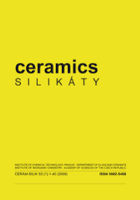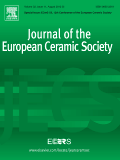
CERAMICS-SILIKATY
Scope & Guideline
Pioneering Insights in Analytical Chemistry and Engineering
Introduction
Aims and Scopes
- Ceramic Materials and Composites:
Research on ceramic materials, including their synthesis, characterization, and applications in various fields such as biomedical, dental, and structural applications. - Cementitious Materials and Concrete Technology:
Studies focusing on various types of cements, their hydration processes, mechanical properties, and the incorporation of supplementary materials to enhance performance. - Nanotechnology and Advanced Materials:
Exploration of nanomaterials and their integration into ceramic and cement composites to improve mechanical, thermal, and electrical properties. - Environmental Sustainability:
Research on the use of waste materials, recycling processes, and sustainable practices in the production of ceramic and cementitious materials. - Corrosion and Durability Studies:
Investigations into the corrosion behavior of ceramic and cement-based materials in various environments, assessing long-term performance and durability.
Trending and Emerging
- Sustainable Materials and Recycling:
A growing emphasis on the use of recycled materials and sustainable practices in the production of ceramics and cements, highlighting the importance of environmental impact and resource conservation. - Advanced Nanocomposites and Hybrid Materials:
Increasing research on nanocomposites and hybrid materials that combine polymers, ceramics, and metals to enhance material properties for specific applications. - Biomedical Applications of Ceramics:
An emerging focus on the use of ceramic materials in biomedical applications, including drug delivery systems and biocompatible implants, driven by advancements in tissue engineering. - Smart and Functional Materials:
Research on the development of smart materials that respond to external stimuli, such as temperature and pH, indicating a trend towards functional ceramics in various applications. - Digital Fabrication and 3D Printing of Ceramics:
A rising interest in the application of digital fabrication techniques, including 3D printing, to produce complex ceramic structures, reflecting the integration of technology in materials science.
Declining or Waning
- Traditional Ceramics without Innovative Approaches:
There has been a noticeable decrease in research focused solely on conventional ceramic materials without the integration of modern techniques or applications, suggesting a shift towards more innovative and advanced materials. - Basic Mechanical Characterization:
Studies that only focus on basic mechanical properties of materials, without exploring the underlying mechanisms or advanced characterization techniques, are becoming less prevalent. - Standardized Laboratory Testing Methods:
Research that strictly adheres to traditional testing methods without incorporating innovative or real-world applications is declining, as there is a growing preference for studies that provide practical insights.
Similar Journals

Korean Journal of Materials Research
Connecting Ideas, Inspiring DiscoveriesKorean Journal of Materials Research is a pivotal publication in the field of materials science, offering a platform for innovative research and comprehensive reviews in miscellaneous materials applications. Published by the MATERIALS RESEARCH SOC KOREA, this journal has been a valuable resource since its inception in 2007 and continues to disseminate vital findings through 2024. Although currently categorized in Q4 of the Materials Science quartiles, the journal is committed to advancing knowledge and fostering research collaboration within the scientific community. With an ISSN of 1225-0562 and an E-ISSN of 2287-7258, the journal aims to bridge gaps in research and practice, appealing to a diverse audience of researchers, professionals, and students interested in the latest advancements in materials science. While access to content may not be open, the journal's impact in the regional and global research landscape is steadily growing, as indicated by its Scopus ranking in the 7th percentile of General Materials Science. Engage with the Korean Journal of Materials Research to stay at the forefront of materials innovation!

Journal of the Australian Ceramic Society
Advancing the Science of Ceramics and CompositesThe Journal of the Australian Ceramic Society, with ISSN 2510-1560 and E-ISSN 2510-1579, is a distinguished publication by SPRINGER, dedicated to advancing the field of ceramics and composites. Located in Switzerland, this journal serves as a vital platform for researchers, professionals, and students in the realm of materials science, particularly focusing on the innovative applications and developments within ceramics and materials chemistry. Achieving a Q3 quartile ranking in both the Ceramics and Composites and Materials Chemistry categories in 2023, it reflects its commitment to fostering knowledge exchange and intellectual discourse in these critical areas, as evidenced by its Scopus rankings. Spanning from 2007 to 2024, the journal not only supports rigorous peer-reviewed research but also encourages accessibility to cutting-edge findings, making it an essential resource for anyone engaged in ceramic materials research.

REFRACTORIES AND INDUSTRIAL CERAMICS
Elevating Standards in Refractory MaterialsREFRACTORIES AND INDUSTRIAL CERAMICS is a prestigious journal published by Springer, dedicated to the field of ceramics and composite materials. With an ISSN of 1083-4877 and an E-ISSN of 1573-9139, this journal plays a pivotal role in fostering advances in the development, formulation, and application of refractories and industrial ceramics. The journal has been actively publishing since 1996 and is recognized for its contribution to the academic discourse in the ceramics community. Although it currently holds a Q4 ranking in both Ceramics and Composites and Materials Chemistry categories, it serves as an important platform for emerging research trends and innovations, making it essential reading for researchers, professionals, and students engaged in material science. While access is not open, the journal ensures that high-quality research reaches its audience, reflects the evolving landscape of the ceramics industry, and encourages interdisciplinary collaboration.

Transactions of the Indian Ceramic Society
Elevating Understanding in Materials ScienceTransactions of the Indian Ceramic Society is a distinguished journal published by Taylor & Francis Ltd, focusing on the vital field of ceramics and composites. With an ISSN of 0371-750X and an E-ISSN of 2165-5456, this journal serves as a crucial platform for disseminating cutting-edge research and innovations in ceramic materials science. Operating since 1941, it has established a solid reputation within the academic community, currently holding a Q3 ranking in the Ceramics and Composites category according to the 2023 Scopus rankings. Though not an open-access journal, it provides a wealth of insights and findings that can significantly impact both theoretical and practical applications in materials science. The journal aims to facilitate knowledge exchange among researchers, professionals, and students, thereby pushing the boundaries of what is possible in the world of ceramics. It is a valuable resource for anyone looking to advance their understanding and contribute to this ever-evolving field.

Journal of the European Ceramic Society
Transforming Insights into Ceramic ExcellenceThe Journal of the European Ceramic Society, published by Elsevier, is a premier academic periodical dedicated to the cutting-edge advancements in the fields of ceramics and composites, as well as materials chemistry. With an impressive impact factor that places it in the top quartile (Q1) of its category, it ranks #33 out of 317 in Materials Science and #16 out of 127 in Ceramics and Composites, showcasing its strong influence in the scientific community. Established in 1989 and set to converge until 2025, this journal serves as a critical platform for researchers and professionals to disseminate their findings, share ideas, and foster collaboration in the rapidly evolving area of ceramic materials. Although it does not offer Open Access options, the journal ensures rigorous peer review and maintains high standards for publication, making it an essential resource for students, academics, and industry experts who are pushing the boundaries of material science.

Materia-Rio de Janeiro
Fostering collaboration for impactful scientific discoveries.Materia-Rio de Janeiro is a distinguished open-access journal published by UNIV FED RIO DE JANEIRO, LAB HIDROGENIO, dedicated to advancing knowledge in the fields of Chemistry, Materials Science, and Physics. Since its inception in 2006, the journal has established a platform for the dissemination of innovative research, fostering collaboration among researchers globally. The journal's commitment to open access promotes the widespread availability of valuable scientific findings, making it an essential resource for academia and industry professionals alike. With a focus on diverse disciplines, Materia-Rio de Janeiro holds a Q4 classification in multiple categories for 2023, indicating its relevance in the expansive landscape of materials research. Operating from Rio de Janeiro, Brazil, this journal serves as a vital conduit for emerging scientific insights, hence delivering impactful contributions to the global research community.

Processing and Application of Ceramics
Unlocking the Potential of Ceramic MaterialsProcessing and Application of Ceramics is a prominent open-access journal dedicated to the advancement of knowledge in the field of ceramics and composites. Published by the University of Novi Sad, Faculty of Technology in Serbia, this journal has been fostering research and innovation since its inception in 2007. With its ISSN 1820-6131 and E-ISSN 2406-1034, this journal is indexed in Scopus, where it holds a ranking of #82 out of 127 in the Materials Science category, placing it in the 35th percentile and within the Q3 quartile as of 2023. Spanning a convergence period from 2014 to 2024, the journal serves as a vital platform for researchers, professionals, and students alike, eager to explore the latest developments in ceramic materials, their processing techniques, and practical applications. The journal's commitment to accessibility and quality makes it an essential resource for those aiming to stay at the forefront of ceramics research.

JOURNAL OF CERAMIC PROCESSING RESEARCH
Elevating Knowledge in Ceramic Processing ExcellenceJOURNAL OF CERAMIC PROCESSING RESEARCH, published by the Korean Association for Crystal Growth, Inc., serves as a vital source of scholarly communication in the field of ceramics and composites. With an ISSN of 1229-9162, this well-regarded journal aims to advance knowledge through rigorous research and publication of innovative studies that push the boundaries of ceramic processing technologies. Indexed in Scopus and boasting a 2023 Q3 ranking in the ceramics category, it provides a platform for researchers to disseminate their findings and engage with emerging trends in material science. The journal reflects a commitment to contributing to the scientific community, emphasizing the importance of interdisciplinary collaboration and advancements in fabrication techniques. Although it operates under a traditional access model, the journal is a beacon for researchers, professionals, and students, inviting them to explore breakthroughs from the years 2000 through 2024 and beyond.

University Politehnica of Bucharest Scientific Bulletin Series B-Chemistry and Materials Science
Advancing Knowledge in Chemistry and Materials ScienceUniversity Politehnica of Bucharest Scientific Bulletin Series B-Chemistry and Materials Science is a renowned academic journal published by POLYTECHNIC UNIV BUCHAREST, situated in Romania. With the ISSN 1454-2331, this journal serves as a dynamic platform for the dissemination of innovative research findings in the fields of chemistry and materials science. Although classified in the Q4 quartile of both Chemistry (miscellaneous) and Materials Science (miscellaneous) categories for 2023, it has made a significant impact by providing a venue for emerging scholars and established researchers alike to share their work. The journal seeks to bridge theoretical insights and practical applications, promoting interdisciplinary dialogue and advancing scientific understanding. The scope encompasses a broad range of topics, reflecting contemporary advancements and challenges within the field. To facilitate access to its articles, while it does not currently operate under an open-access model, the journal remains committed to enhancing visibility through digital libraries. With a publication history spanning from 1999 to 2024, the journal is vital for all stakeholders—researchers, professionals, and students—seeking to stay abreast of developments in chemistry and materials science.

Cement Wapno Beton
Shaping the Landscape of Modern ConstructionCement Wapno Beton is a renowned academic journal published by STOWARZYSZENIE PRODUCENTOW CEMENTU, focusing on the intricate fields of building and construction, as well as materials science. With the ISSN number 1425-8129, this publication has been committed to advancing knowledge and fostering innovation since its inception in 2007, and it will continue until 2024. The journal operates within a competitive landscape, as reflected in its 2023 Scopus rankings, placing it in the third quartile (Q3) in both Building and Construction and Materials Science categories. Although it currently does not offer open access options, Cement Wapno Beton remains an essential resource for researchers, professionals, and students seeking valuable insights into the latest developments and technologies in construction materials. Its scope encompasses a wide range of topics, including architectural advancements, sustainable building practices, and innovative material applications, making it an indispensable tool for those dedicated to the evolution of construction science.